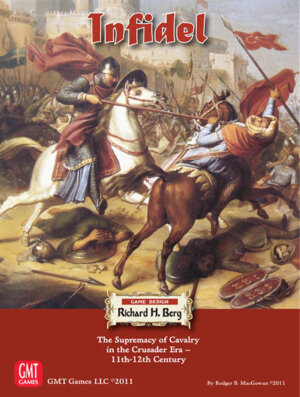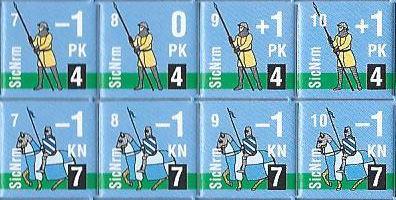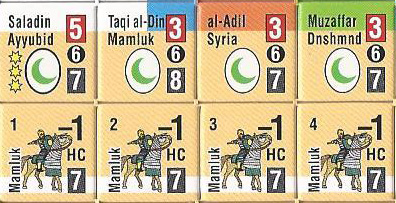
Publisher: GMT Games
Designer: Richard H. Berg
Artists: J. J. Dassy, Mike Lemick, Rodger B. MacGowan, and Mark Simonitch
Year: 2011
Players: Two players (with solitaire rules)
Ages: 13+ (my estimate)
Playing time: One to two hours, or more, depending on the scenario
Genre: Wargame set during the era of the Crusades
MSRP: $55.00
Sometimes it seems as if a designer will get dogpiled by negative reaction to a design and gamers need to be reminded that that person still has some design juice left in their bones. A good example of this is Richard H. Berg. Recently his Godzilla: Kaiju World Wars was released and I don’t think I’d be exaggerating in saying it was a disaster. I won’t carry on about it because you can read Elliott’s review and listen to our thoughts on the latest episode of the show. We’ve heard a lot of talk, from gamers, that this was an example of another designer who lost his/her mojo and was cranking out loser after loser title.
I’m pleased to say that Mr. Berg still has good work in him after playing GMT’s Infidel. Unfortunately, for Mr. Berg, this game probably won’t appeal to as wide an audience as Godzilla will so his reputation with those gamers may still be blemished.

Infidel is a fast learned, and played, follow up to GMT’s Men of Iron which covered battles between the English and Scots during the 14th Century. Infidel turns back the clock a few more centuries and tackles the early Crusades of the 11th and 12th centuries. This was an era where the mounted knight reigned supreme and the game includes seven battles of the period in which to test your mastery of cavalry. It’s important to note that some of the battles are a bit one sided but in the scenario notes you’ll find ahistorical options to even things up a bit; some players just hate to take on the role of a historically defeated opponent.
The quality of the components is very nice and the rule book is smartly laid out so learning how to play is accomplished in a relatively short period. The counters are colorful and stand out well. Since the battles took place in mainly what was desert (it is the Crusades for crying out loud) the maps are a little on the bare side but we’re not talking just one big sheet of desert hexes. The maps are double sided but they aren’t mounted. I suppose that’s the price we have to pay but the map stock is strong and well finished so it should hold up well.
Not having played Men of Iron, I wasn’t familiar with the game system but after giving Infidel the go ‘round I found it very intriguing. The game is not played in turns. That’s right, there are no turns in Infidel but is driven by a mechanic known as Continuation Activation. What this entails is one side activates a unit of troops and then moves and of fires if they are archers and attacks in close combat. They then follow that up with selecting another command to repeat the process. At this point their opponent has the opportunity to seize the Continuity (or maybe I would refer to it as the initiative) based upon the Activation rating of selected unit’s commander. If the roll falls within the rating’s range on a d10 then the unit will be able to activate and proceed. If the roll is higher, the opponent now has the ability to activate one of his commands and, once finished with that unit try to activate another. This continues along and creates a wonderful back and forth as you’ll curse the dice (or your commanders) when you suddenly find your carefully planned attacks losing momentum or an enemy unit slip from your grasp.

Infidel also portrays the role of heavy cavalry outstandingly. Some folks might think that heavy cavalry were named so simply because of the amount of armor they were laden with. In reality, heavy cavalry horses were much larger than other equestrians and were bred specifically to barrel into opposing combat formations carrying their rider – who normally would have been the one heavily armored – forward providing a hammer of momentum upon impact. This was the shock and awe attack of the Middle Ages.
In the game, only knights or heavy cavalry can charge enemy units and if planned correctly (and with a good die roll) can be devastating to the enemy during the Shock Phase. Other units other than knights and heavy cavalry can use shock attacks but these two mounted units are mighty effective at it. Shock attacks are used to not only cause casualties but also to drive defenders from their positions. I will point out that the charge rules do take a little getting used to but after a while they’re easily remembered.
As the battle rages on, both sides need to be aware of the flight level of their forces. If this level is reached then they have automatically lost and are considered to be leaving the field. Elimination of leaders, mounted units, and so forth add to your flight points. The battle can end before this level is reached because you track your current flight points and when a check is called for a d10 is rolled and the die result is added. Some people might not like the uncertainty of this random modifier but it does add tension to the game as you might find your forces fleeing the field of battle long before you expected.
All in all Infidel is a good game. I enjoy the Continuation Activation aspect and I was surprised by how the battles I played became rather fluid as opposed to static defenses; the battlegrounds were a constantly shifting canvas. For some the level of detail may be lacking but the overall feel of the time period is well presented in exciting, if sometimes one sided affairs. For myself, there are enough diverse unit types to make each battle unique without diving too deeply into minutia that could bog down play.

[rwp-review id=”0″]


















